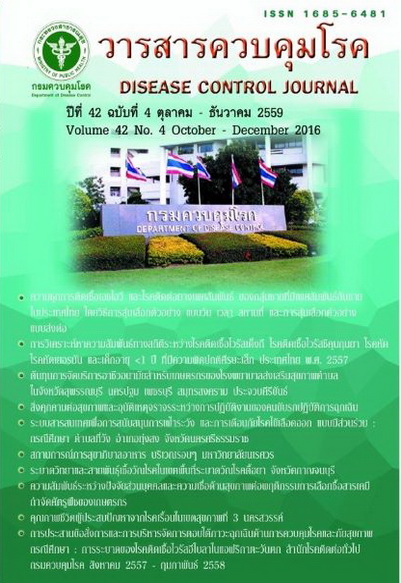Statistical correlations between infection of dengue viruses, chikungunya virus, measles, rubella and children with microcephaly less than one year of age in Thailand, 2014
DOI:
https://doi.org/10.14456/dcj.2016.2Keywords:
statistical correlations, dengue viruses, chikungunya virus, measles, rubella, child with microcephalyAbstract
Brazil has had the overwhelming outbreak of Zika virus that has coincident increasing numbers of neonatal microcephaly. The symptoms are similar to other arbovirus and Zika virus infection is also transmitted by the same species of mosquito as dengue virus that has caused considerable disease burden in Thailand. To explore a possibility of Zika virus linked to microcephaly, a cross sectional was conducted to describe correlations between infection of dengue viruses, chikungunya virus, measles, rubella and children diagnosed with microcephaly at less than one year of age in Thailand. The databases on Bureau of Policy and Strategy, Ministry of Public Health were queried for microcephaly with ICD-10-Q2 documented in 2014. We analyzed information of dengue fever, chikungunya, measles and rubella cases in 2013, of which were reported through the national disease surveillance system to the information center at Bureau of Epidemiology, Department of Disease Control. Prevalence of microcephaly and morbidity rates of all diseases were explored during one-year lag using Spearman’s rank correlation coefficient. There were 31 cases and prevalence of neonatal micro¬cephaly was 4.36 cases per 100,000 live births. Among children with microcephaly less than one year of age, there were 159 cases (an age-specific prevalence was 22.34 cases per 100,000 populations). The northeastern region had the highest prevalence per 100,000 populations. Twelve clusters (27 cases) from 11 provinces were detected. There was a statistical correlation between the age-specific prevalence of microcephaly in children less than one year of age and morbidity rate of dengue virus in females between 15-44 years (r = 0.32, p = 0.004), but were not found any statistical correlations in morbidity rate of chikungunya virus, measles and rubella in females between 15-44 years. The results could estimate a burden of microcephaly in Thailand, but clearly this was not true of prevalence. A prospective cohort study needs to be further conducted in the future. Serious investigation of dengue fever in pregnant women should be set as the first priority on surveillance of neonatal microcephaly to explore possible linkage with Zika virus infection
Downloads
References
2. World Health Organization. WHO statement on the first meeting of the International Health Regulations (2005) (IHR 2005) Emergency Committee on Zika virus and observed increase in neurological disorders and neonatal malforma¬tions [Internet]. [cited 2016 Feb 2]. Available from: http://www.who.int/mediacentre/news/ statements/2016/1st-emergency-commit¬tee-zika/en/
3. FauciAS, Morens DM. Zika virus in the Americas --yet another arbovirus threat. N Engl J Med 2016;374:601-4.
4. สำนักสารนิเทศ สำนักงานปลัดกระทรวงสาธารณสุข. รายงานข่าวไข้ซิกา (Zika virus disease) ประจำวันที่ 2 กุมภาพันธ์ [อินเทอร์เน็ต]. [สืบค้นเมื่อ 2 ก.พ. 2559]. แหล่งข้อมูล: http://beid.ddc.moph. go.th/beid_2014/node/2008
5. Guzman MG, Kouri G. Dengue and dengue hemorrhagic fever in the Americas: lessons and challenges. J Clin Virol 2003;27:1-13.
6. Dubrulle M, Mousson L, Moutailler S, Vazeille M, Faillou AB. Chikungunya virus and Aedes Mosquitoes: saliva Is infectious as soon as two days after oral infection. PLoS ONE 2009;4: e5895. doi:10.1371/journal.pone.0005895.
7. สำนักระบาดวิทยา กรมควบคุมโรค. สรุปรายงานการเฝ้าระวังโรค ประจำปี 2557. กรุงเทพมหานคร: โรงพิมพ์ชุมนุมสหกรณ์การเกษตรแห่งประเทศไทย จำกัด; 2557.
8. สำนักโรคติดต่อนำโดยแมลง กรมควบคุมโรค. สถานการณ์โรคไข้เลือดออกประจำสัปดาห์ที่ 52 ปี 2558 [อินเทอร์เน็ต]. [สืบค้นเมื่อ 6 มี.ค. 2559]. แหล่งข้อมูล: http://www.thaivbd.org/n/dengues /view/491
9. Centers for Disease Control and Prevention (CDC). Zika virus clinical evaluation & disease [Internet]. [cited 2016 Mar 14]. Available: http://www.cdc.gov/zika/ hc-providers/ clinicalevaluation.html
10. Opitz JM, Holt MC. Microcephaly: general considerations and aids to nosology. J Craniofac Genet Dev Biol 1990;10:175-204.
11. สำนักระบาดวิทยา กรมควบคุมโรค. นิยามโรคติดเชื้อประเทศไทย [อินเทอร์เน็ต]. [สืบค้นเมื่อ 14 มี.ค. 2559]. แหล่งข้อมูล: http://203.157.15.6/ktext/cdsur/home.htm>
12. World Health Organization. Microcephaly fact sheet updated 2 March 2016 [Internet]. [cited 2016 Mar 17]. Available from: http://who.int/mediacentre/factsheets/ microcephaly/en/
13. Brasil P, Pereira JP, Gabaglia CR, Damasceno L, Wakimoto M, Nogueira RMR, et al. Zika virus infection in pregnant women in Rio de Janei¬ro--preliminary report. N Engl J Med March 4, 2016. doi: 10.1056/NEJMoa1602412
14. Schuler-Faccini L, Ribeiro EM, Feitosa IML, Horovitz DDG, Cavalcanti DP, Pessoa A, et al. Possible association between Zika virus infection and microcephaly-Brazil, 2015. Morb Mortal Wkly Rep 2016;65:59-62.
15. Simmins Jr CH. Establishing base levels of mi¬crocephaly in Brazil prior to the arrival of Zika viral illnesses [Submitted]. Bull World Health Organ E-pub: 8 Feb 2016. doi: http://dx.doi. org/10.2471/BLT.16.171223
16. Besnard M, Lastere S, Teissier A. Cao-Lormeau VM, Musso. Evidence of perinatal transmission of Zika virus, French Polynesia, December 2013 and February 2014. Euro Surveill [Internet]. 2014 [cited 2016 Mar 14];19:13-6. Available from: http://dx.doi.org/10.2807/1560-7917. ES2014.19.13.20751.
17. Oliveira Melo AS, Malinger G, Ximenes R, Szejnfeld PO, Alves SampaioS, Bispo de Filippis AM. Zika virus intrauterine infection causes fetal brain abnormality and microcephaly: tip of the iceberg? Ultrasound Obstet Gynecol [Internet]. 2016 [cited 2016 Mar 14];47:6-7. Available from: http://dx.doi.org/10.1002/uog.15831
18. Isabel Rodriguez-Barraquer, Henrik Salje, Justin Lessler, Cummings D. Predicting intensities of Zika infection and microcephaly using transmis¬sion intensities of other arboviruses. BioRxiv [Internet]. 2016 [cited 2016 Mar 14] online Feb 24, 2016. Available from: http://dx.doi.org/10.1101/041095
19. Buathong R, Hermann L, Thaisomboonsuk B, Rutvisuttinunt W, Klungthong C, Chinnawirot¬pisan P, et al. Detection of Zika virus infection in Thailand, 2012-2014. Am J Trop Med Hyg 2015;93:380-3.
20. Oehler E, Watrin L, Larre P, Leparc-Goffart I, Lastere S, Valour F, et al. Zika virus infection complicated by Guillain-Barre syndrome - case report, French Polynesia, December 2013. Eurourveill 2014;19:pii=20720.
21. Roth A, Mercier A, Lepers C, Hoy D, Duitutur¬aga S, Benyon E, et al. Concurrent outbreaks of dengue, chikungunya and Zika virus infections an unprecedented epidemic wave of mosquito-borne viruses in the Pacific 2012-2014. Euro Surveill 2014;19:pii=20929.
Downloads
Published
How to Cite
Issue
Section
License
Articles published in the Disease Control Journal are considered as academic work, research or analysis of the personal opinion of the authors, not the opinion of the Thailand Department of Disease Control or editorial team. The authors must be responsible for their articles.






